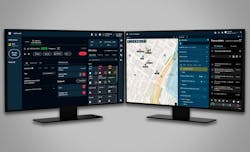The Flow of Information: How AI Helps Police Communications
Over the past few years, 9-1-1 Communication Centers have undergone a transformation when it comes to technology. While the hardware has stayed consistent, the software has made big leaps from AI-assisted programs to the ability to livestream video, audio and interact with both callers and officers on the street in real time.
This article appeared in the September/October issue of OFFICER Magazine. Click Here to subscribe to OFFICER Magazine.
Todd Piett, Corporate Vice President of Command Center Technologies at Motorola Solutions, recently spoke to OFFICER Magazine about some of these advances and how the company tries to strike a balance when it comes to the needs of telecommunicators, first responders and the public.
The speed of information
Over the summer, Motorola Solutions launched VESTA NXT, an expansion of its call-taking solution aimed at increasing efficiency while reducing information overload and stress. The latest iteration of VESTA includes a virtual response assistant that uses AI to resolve non-emergency calls and connect callers to resources. The company touts that the new feature can lessen a call handler’s workload by an estimated 20-35%.
The platform has the ability to bring in data including maps, floor plans and caller information into a single platform and can be shared with officers over Motorola Solution’s APX NEXT P-25 Smart Radios.
“We think of VESTA NXT typically as a call handling platform, but the reality is that we’re really looking at blurring some of those lines between call handling dispatch and all the way even out into field handling, reporting and evidence,” says Piett. “I think a lot about the workflows that are involved in that, not necessarily products, but if you take a step back and think about what’s the end goal? It’s to, at least on a 9-1-1 call, to make sure you’ve got the right resources there as quickly as possible to address the issue for whatever that might be. Whether it be a police issue or medical, EMS, fire, whatever that intent is, if we think about it that way, you start to look at how AI can play a role in really augmenting and improving the workflows across the spectrum.”
When a telecommunicator takes a call, the process is made up of different moving parts. Some information can be provided by the caller, while other information can be searched for in a database. “How do you bring all that together into a concise and accurate story? And then, importantly, how do you get that out to the field in a way that is as close to error free as you can get,” asks Piett. “AI has this amazing ability to automate some of the data capture, the querying, and look across the different information sources.” One of those information sources is the 9-1-1 call itself. AI can transcribe, translate and archive that data. When an address is given, VESTA NXT can help confirm the location. If a profile of the caller was previously created, it can pull up that information for the call taker. For the officer in the field, the system can flag keywords and provide a summary of the call.
Motorola Solutions owns 60% of the market, according to Piett, which allows the company to train its AI model effectively to reduce possible errors. For example, if someone calls 9-1-1 about a child who is waving a broom around like a gun, it would treat it differently than if someone calls to report a man who is pointing a firearm.
“One of the unique things that we’re able to do through this end-to-end ecosystem is push the call summary all the way out to dispatch,” he says. “We can automatically create an incident in CAD, and we can highlight different things from the conversation and can even automate workflows off of that. If you know the words ‘weapon’ and ‘shooter’ are mentioned, and we see that this call came from a school, we can start to automate workflows to notify the school resource officer there in advance of the dispatch even happening.”
Adding capabilities
Both 9-1-1 centers and law enforcement agencies are facing staffing challenges. Through the use of AI, calls can be expedited, and resources can be properly allocated. “In some cases, the officers can go in and access the live call stream and see exactly what was said and what was contextually in that call,” says Piett. “It makes that happen very quickly and easily augment and speed the data entry in process so they can worry about addressing the nuances of a call that only a human can do and not worry about typing in all the data that we can easily pull from systems. Those are some of the ways we’re looking at how AI can really transform the response workflow.”
By being able to push the information over to the APX NEXT radios, the officers in the field have the information in their hands and can see the profiles, summaries, floor plans and more before they step inside the door. “It’s really about how you pull all of this technology and data together into a way that makes for the entire incident response. From the time that phone call is made, or potentially before when someone recognizes there was an incident, all the way to the point that the incident is resolved,” he says. “If you look at them as individual products and workflows, you miss the bigger picture of how it can all be stitched together. AI plays a big role in that.
He clarifies that while information gathering is key, it’s also important to sift through that data and only share what is necessary. “You don’t want to inundate the user with everything. You don’t just send them everything. You want to use and AI to help nudge along the people. You’re not changing it; you’re augmenting their process.”
Ease of training
When introducing new technology, Piett stressed that the training involved must not be cumbersome. “It has to be something that’s easy to train on and adapt to. There are a lot of good reasons existing workflows are in place, and a lot of folks are a little more set in their ways. How do you augment that without completely flipping everything that does work on its end?” He adds that there was not as much pushback from the call takers as expected following the initial rollout of VESTA NXT. “If you make somebody’s job easier, they’re far more likely to use the solution. The adoption actually becomes really tied to the value they see and people are super willing to do it.”
He says that companies, and agencies run into problems when changed is forced through technology that doesn’t make the lives of the call takers and first responders easier or adds to their workload down the road. “It’s important to not worry about the technology as much as the workflow. Technologies are enablers of workflow improvement.”
About the Author
Paul Peluso
Editor
Paul Peluso is the Managing Editor of OFFICER Magazine and has been with the Officer Media Group since 2006. He began as an Associate Editor, writing and editing content for Officer.com. Previously, Paul worked as a reporter for several newspapers in the suburbs of Baltimore, MD.




